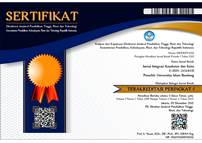Gula Darah Sewaktu Tidak Dapat Memperkirakan Kejadian TB pada Pasien DM Tipe 2
Abstract
Tuberkulosis (TB) merupakan penyakit infeksi yang menempati peringkat utama penyebab kematian di dunia. Indonesia berada pada peringkat ke-3 dari 30 negara yang memiliki kasus TB terbanyak. Diabetes melitus (DM) tipe 2 merupakan salah satu faktor risiko terjadi TB. Paparan hiperglikemi pada pasien DM tipe 2 dapat memengaruhi sistem imun hingga lebih rentan menderita TB. Penelitian ini bertujuan menganalisis hubungan gula darah sewaktu pada saat pertama didiagnosis DM tipe 2 dengan kejadian TB paru pada pasien DM tipe 2 di RSUD Al-Ihsan Bandung. Penelitian ini merupakan penelitian observasional analitik dengan pendekatan kasus kontrol. Kelompok kasus berjumlah 34 orang pasien DM tipe 2 yang mengalami TB, sedangkan kelompok kontrol berjumlah 59 pasien DM tipe 2 tanpa TB. Data penelitian merupakan data sekunder yang berasal dari rekam medis pasien. Pengumpulan dan pengolahan data diambil sesuai dengan kriteria inklusi dan eksklusi. Hasil penelitian terhadap 93 orang subjek di RSUD Al-Ihsan menunjuk bahwa pasien yang memiliki hiperglikemia berjumlah 19 pasien (56%) pada kelompok kasus dan 35 pasien (59%) pada kelompok kontrol. Hasil uji chi square didapatkan bahwa nilai p adalah 0,746 (p > 0,05) dengan alpha 5% (0,05), odd ratio sebesar 0,868. Berdasar atas hasil uji analitik terhadap data penelitian dapat disimpulkan bahwa gula darah sewaktu pada pasien DM tipe 2 belum dapat menilai kemungkinan terjadi kejadian TB.
Random Blood Sugar Unable to Predict the Incidence of TB in Type 2 DM Patients
Tuberculosis (TB) the world’s leading cause of death from a single infectious disease. Indonesia is ranked 3rd out of the 30 countries with the most TB cases. Hyperglycemic exposure in type 2 DM patients can affect the immune system, making it more susceptible to TB. This study aims to look at the relationship of random blood sugar levels at the first time patient diagnosed as type 2 DM in pulmonary TB patients with type 2 DM at Al-Ihsan Hospital Bandung. During this study used an analytic observasional method in case control study. The sample of this study was a group of 34 dm type 2 patients experienced TB, while the control group were 59 Type 2 DM patients without TB.. The research was obtained from secondary data from medical record. This collection and processing data were taken in the inclusion criteria. The results of the study conducted on 93 people showed that in Al-Ihsan Hospital there was 54 patients (15%) had hyperglycemia and 39 patients (42%) had normoglycemia. Type 2 DM patients who experienced TB were 34 patients (37%), the results of analytical tests obtained that type 2 DM patients who had Pulmonary TB percentage was more common in patients with normal random blood sugar at 38.5% (15 patients). From the results of this study known p value > 0.746 with alpha 5% (0.05) with odd ratio 0.868. Based on this study shows that there is no relationship between blood sugar levels of dm type 2 patients and the incidence of pulmonary TB.
Keywords
Full Text:
PDFReferences
Kementerian Kesehatan Republik Indonesia. Peningkatan Penyakit Menular, 2018;468.
World Health Organization. Global tuberculosis report. 2019;339.
Dinas Kesehatan Provinsi Jawa Barat.2019; 159.
Irvine WJ. Classification of Diabetes Mellitus. 2019 Jun 1;309(11):12023.
Wijaya I. Tuberkulosis Paru pada Penderita Diabetes Melitus. 2015 Mar 8;42(6):412–7.
World Health Organization. Collaborative framework for care and control of World Health. 2011 Aug 5;314(5805):32–5.
Internation Diabetes Federation. IDF Diabetes Atlas 9th edition. 2019:10–106.
Lin Y, Harries AD, Kumar AM, Critchley JA, Crevel R Van, Owiti P, dkk. Management of Diabetes Mellitus-Tuberculosis: a guide to the essential practice. 2018:1–94.
Dirjen Pengendalian Penyakit dan Penyehatan Lingkungan. Petunjuk Teknis Penemuan Pasien TB-DM Di Fasilitas Kesehatan Rujukan Tingkat Lanjut. Kementeri Kesehat RI. 2015:1–39.
Zheng C, Hu M, Gao F. Diabetes and pulmonary tuberculosis: a global overview with special focus on the situation in Asian countries with high TB-DM burden. Glob Health Action. 2017;10(1):264-72.
Chitnis, A S SGF. Co-morbidities & Special Situations. In: a survival guide for clinicians : edisi ke-3. 2016:173–96.
Workneh MH, Bjune GA, Yimer SA. Prevalence and associated factors of tuberculosis and diabetes mellitus comorbidity: A systematic review.2017: 3548.
World Health Organization. Classification of Diabetes Mellitus 2019 Sep 6: 249.
Pal R, Ansari MA, Hameed S, Fatima Z. Diabetes Mellitus as Hub for Tuberculosis Infection: A Snapshot. 2016 Dec 22:569.
Lin Y, Yuan Y, Zhao X, Liu J, Qiu L, He X, dkk. The change in blood glucose levels in tuberculosis patients before and during anti-tuberculosis treatment in China. 2017 Okt 17;10(1):669.
Philips L, Visser J, Nel D, Blaauw R, dkk. The association between tuberculosis and the development of insulin resistance in adults with pulmonary tuberculosis in the Western sub-district of the Cape Metropole region, South Africa: a combined cross-sectional, cohort study. 2018 Jun 8;62(2):254-62.
DOI: https://doi.org/10.29313/jiks.v3i1.7402
Refbacks
- There are currently no refbacks.
Jurnal Integrasi Kesehatan dan Sains is licensed under a Creative Commons Attribution-NonCommercial-ShareAlike 4.0 International License.







.png)
_(1).png)




















